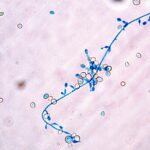
Lomentospora prolificans
3 Οκτωβρίου, 2025Future Prospects and Challenges in Mucormycosis Research
3 Οκτωβρίου, 2025Abstract
Mucormycosis is a fungal infection caused by Mucorales fungi that cause severe disease and fatality, especially in immunocompromised individuals. Although vaccines and immunotherapeutics have been successful in combating viral and bacterial infections, approved anti-fungal immunotherapies are yet to be realized. To address this gap, monoclonal antibodies targeting invasive fungal infections have emerged as a promising approach, particularly for immunocompromised patients that are unlikely to maximally benefit from vaccines. The Mucorales spore coat proteins (CotH) have been identified as crucial fungal invasins that bind to glucose-regulated protein 78 (GRP78) and integrins of host barrier cells. Previously, we described a murine monoclonal antibody, anti-CotH C2, which protected diabetic ketoacidosis (DKA) and neutropenic mice from mucormycosis. Here, we advanced the development the C2 IgG1 by humanizing it, establishing a stable Chinese hamster ovary (CHO) cell line producing the antibody at commercial yields, and carried out optimization of the upstream and downstream manufacturing processes. The resultant humanized IgG1 (VX-01) exhibited a ten-fold increase in binding affinity to CotH proteins and conferred comparable in vitro and in vivo efficacy when compared to C2 antibody. The mechanism of protection was reliant on prevention of angioinvasion and enhancing opsonophagocytic killing. VX-01 demonstrated acceptable safety profiles with no detectable damage to host cells in vitro and weak or moderate binding to only cytoplasmic proteins in ex vivo Good Laboratory Practices (GLP)-human tissue cross reactivity studies. Our studies warrant continued development of VX-01 as a promising adjunctive immunotherapy. (read more)
Gu Y, Singh S, Alqarihi A, Alkhazraji S, Gebremariam T, Youssef EG, Liu H, Fan X, Jiang WR, Andes D, Cochrane TR, Schwartz JA, Filler SG, Uppuluri P, Ibrahim AS. Sci Transl Med. 2025 Mar 12;17(789):eads7369. doi: 10.1126/scitranslmed.ads7369
